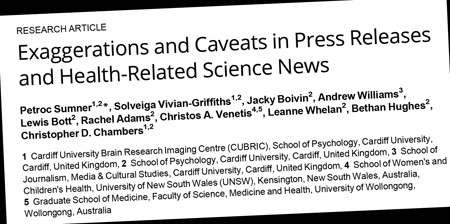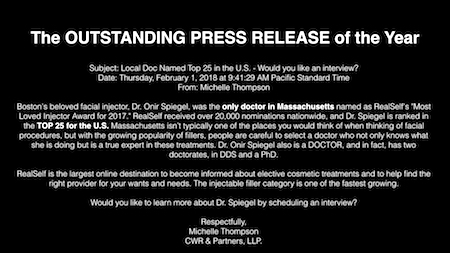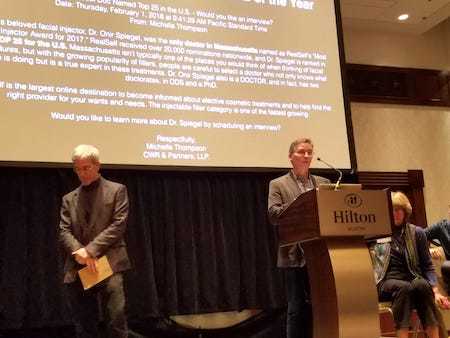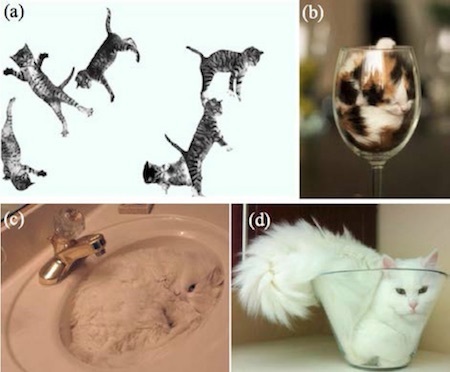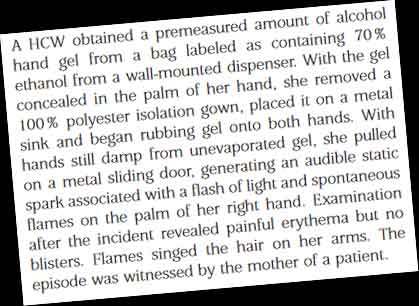Marc Abrahams's Blog, page 195
February 21, 2018
Macaques Form Preferences for Brand Logos Through Sex and Advertising [research study]
A further advance in understanding the value of butt recognition:
“Rhesus Macaques Form Preferences for Brand Logos Through Sex and Social Status Based Advertising,” M. Yavuz Acikalin, Karli K. Watson, Gavan J. Fitzsimons, and Michael L. Platt, PloS ONE, vol. 13, no. 2, 2018, e0193055. (Thanks to David Austin for bringing this to our attention.) The authors, at Stanford University, Stanford, the University of Colorado Boulder, Duke University, and the University of Pennsylvania, report:
“we asked whether rhesus macaques (Macaca mulatta) show choice behavior that is similar to humans in response to sex and social status in advertising. Our results show that monkeys form preferences for brand logos repeatedly paired with images of macaque genitals and high status monkeys.”
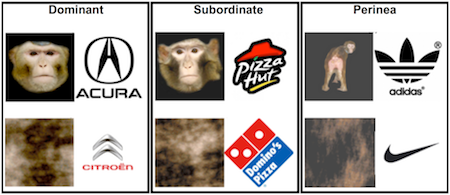
This new study fails to mention the Ig Nobel Prize-winning research that made it possible. The 2012 Ig Nobel Prize for anatomy was awarded to Frans de Waal and Jennifer Pokorny, for discovering that chimpanzees can identify other chimpanzees individually from seeing photographs of their rear ends. They describe their findings in the study “Faces and Behinds: Chimpanzee Sex Perception” [Frans B.M. de Waal and Jennifer J. Pokorny, Advanced Science Letters, vol. 1, 99–103, 2008].

Awaiting the press release for the press release exaggerations study
We are eager to see the press release (if there is one) that heralds this research study:
“Exaggerations and Caveats in Press Releases and Health-Related Science News,” Petroc Sumner, Solveiga Vivian-Griffiths, Jacky Boivin, Andrew Williams, Lewis Bott, Rachel Adams, Christos A. Venetis, Leanne Whelan, Bethan Hughes, and Christopher D. Chambers, PLoS One, vol. 11, no. 12, 2018, e016821.
BONUS (perhaps related): The OUTSTANDING PRESS RELEASE of the Year.

February 19, 2018
Earprints as criminal evidence
“An earprint is an impression of the external ear. House breakers may leave their earprints inadvertently when they listen at doors and windows to check if there is anyone inside before breaking and entering a premises. Owing to uniqueness and individualistic characteristics of the human ear, earprints can be used as evidence to link a criminal with the crime. In the recent past, many suspected thieves have been convicted and several burglaries linked due to the presence of similar earprints.”
So writes Professor Kewal Krishan of Panjab University, India, in ‘Identification: Prints – Ear (Earprints)’, in the Encyclopedia of Forensic and Legal Medicine (Second Edition) 2016. [At the time of writing the book is on special offer at $1,375.00 – down from its usual list price of $2,100.00]
As an alternative, you can find out more about earprints via ‘Earprint recognition based on an ensemble of global and local features’ Security Technology (ICCST), 2015 International Carnahan Conference on. A copy of which may be found here, free of charge : 
“The earmarks are usual evidences in many real criminal investigations. The earprint appears for example when a criminal tries to listen through a window or a door before entering, and the methods to make it visible are similar to those used in latent fingerprint lifting. However, its acceptance as evidence in real prosecutions still raises doubts. Although it is well-accepted the uniqueness of the ear and its usefulness for person identification, the permanence of such discriminate ability in earprints is not obvious.”
Some of the doubts outlined above might arise from consideration of stories such as this one from The Guardian, 2004. ‘Earprint landed innocent man in jail for murder’
Also see : Unconstrained ear recognition progress

February 18, 2018
OUTSTANDING PRESS RELEASE of the Year: “Most Loved Injector”
Here is the verbatim text of the OUTSTANDING PRESS RELEASE of the Year:
Date: Thursday, February 1, 2018 at 9:41:29 AM Pacific Standard Time
From: Michelle Thompson
Boston’s beloved facial injector, Dr. Onir Spiegel, was the only doctor in Massachusetts named as RealSelf’s “Most Loved Injector Award for 2017.” RealSelf received over 20,000 nominations nationwide, and Dr. Spiegel is ranked in the TOP 25 for the U.S. Massachusetts isn’t typically one of the places you would think of when thinking of facial procedures, but with the growing popularity of fillers, people are careful to select a doctor who not only knows what she is doing but is a true expert in these treatments. Dr. Onir Spiegel also is a DOCTOR, and in fact, has two doctorates, in DDS and a PhD. RealSelf is the largest online destination to become informed about elective cosmetic treatments and to help find the right provider for your wants and needs. The injectable filler category is one of the fastest growing.
Would you like to learn more about Dr. Spiegel by scheduling an interview?
Respectfully,
Michelle Thompson CWR & Partners, LLP.
The OUTSTANDING PRESS RELEASE of the Year was announced on Saturday night, February 17, 2018, at the Annual Meeting of the American Association for the Advancement of Science (AAAS), in Austin, Texas, in the special Improbable Research session.
The Committee of Reporters who Receive and Appreciate Press Releases (Rosie Mestel, Bob Finn, Maggie Fox, Michael Newman, Bethany Brookshire, Marc Abrahams) made the selection. It was given a dramatic reading, at the event, by John Rennie, editor of Quanta magazine and former editor of Scientific American magazine. The audience responded with genteel, subdued emotion sustained by gentle applause.
PS. If you were at the event, and have video of the dramatic reading, we urge you to put it on YouTube and send us the URL.
Technical details
Nominees: The OUTSTANDING PRESS RELEASE of the Year is selected from amongst all the press releases considered by the selection committee.
Selection criterion: The OUTSTANDING PRESS RELEASE of the Year exemplifies a singular quality: it stands out.
UPDATE: Journalist David Levine photographed John Rennie dramatically reading aloud the OUTSTANDING PRESS RELEASE OF THE YEAR:

February 15, 2018
Improbable Research at AAAS — Saturday Night in Austin
Join us for the Improbable Research session at the American Association for the Advancement of Science (AAAS) Annual Meeting, in Austin Texas!
When: Saturday night, February 17, 8:00 pm.
Where: Hilton Austin Hotel— Salon H, Austin, Texas
The event will include will include:
Marc Abrahams , founder of the Ig Nobel Prize ceremony
Ig Nobel Prize winner Alex Suarez (Zurich, Switzerland)—Using a didgeridoo to treat sleep apnea and snoring
Robert Kirshner (Harvard U)—The Universe
Ig Nobel Prize winner Liza Shapiro (U Texas)—Why pregnant women don’t tip over
Bill Press (U Texas, and past president of the AAAS) and John Hawkins (U Texas)—Comparative genomics of rubber chicken
Ed Theriot (Texas Memorial Museum, U Texas)—The taxonomy of Barney
The Committee of Reporters who Receive and Appreciate Press Releases will announce its selection of the Outstanding Press Release of the Year
This special session is open to the public, free of charge. This is the twenty-somethingth year we’ve done this kind of event at the AAAS meeting. It always draws an overflow crowd. So… we suggest you arrive a little early, to ensure finding a seat.
Here’s an image from one of the Ig Nobel Prize-winning studies we will discuss. The study asks the question “Can a cat be both a solid and a liquid?”

A flash fire caused by a hospital hand sanitizer
It sometimes happens that a solution to a problem ends up creating a new problem. As an example, here’s a case in which the solution was a 70% alcohol-based gel in a wall-mounted dispenser in a hospital. The gel was intended to resolve so-called nosocomial problems associated with poor hand hygiene in hospitals. Unfortunately, a health care worker (HCW) removed a 100% polyester isolation gown shortly after using the sanitiser, causing a static electricity spark (at least 3000 volts) which then ignited the gel on her hands and arms :
The report of the incident lead to the temporary removal of alcohol-based hand santisers in some hospitals, including those where healthcare professionals had been found repetitively licking their fingers while reviewing hospital charts.
Coming Soon: Even more problems with hand sanitizers . . .

February 14, 2018
OUTSTANDING PRESS RELEASE of the Year
The
OUTSTANDING PRESS RELEASE of the Year
will be announced
at the Annual Meeting of the American Association for the Advancement of Science (AAAS),
in the special Improbable Research session.
WHERE: Hilton Austin Hotel, Austin, Texas — in Salon H.
WHEN: Saturday night, February 17, 2018, 8:00 pm.
Selected by the
Committee of Reporters who Receive and Appreciate Press Releases
(Rosie Mestel, Bob Finn, Maggie Fox, Michael Newman,
Bethany Brookshire, Marc Abrahams)
 Nominees: The OUTSTANDING PRESS RELEASE of the Year is selected from amongst all the press releases considered by the selection committee.
Nominees: The OUTSTANDING PRESS RELEASE of the Year is selected from amongst all the press releases considered by the selection committee.
Selection criterion: The OUTSTANDING PRESS RELEASE of the Year exemplifies a singular quality: it stands out.
Admission to the event: The OUTSTANDING PRESS RELEASE of the Year announcement event is open to all accredited journalists, all registered attendees of the Annual Meeting of the American Association for the Advancement of Science (AAAS), and to the public, free of charge.

February 12, 2018
Finger licking bad (in rehabilitation units)
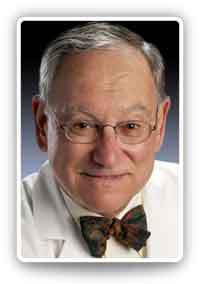 The nosocomial problems associated with healthcare professionals repetitively licking their fingers while reviewing hospital charts was first formally documented by Myron M. LaBan, MD FAAPMR – the lead author of a 2004 brief report for the American Journal of Physical Medicine & Rehabilitation (Volume 83, Issue 1, pp. 75-78). The report encouraged healthcare professionals to :
The nosocomial problems associated with healthcare professionals repetitively licking their fingers while reviewing hospital charts was first formally documented by Myron M. LaBan, MD FAAPMR – the lead author of a 2004 brief report for the American Journal of Physical Medicine & Rehabilitation (Volume 83, Issue 1, pp. 75-78). The report encouraged healthcare professionals to :
1) Wash their hands before and after reviewing medical charts.
2) Become aware of (and ideally refrain from) licking their fingers.
Also see: (from Dr. LaBan)
• Airport induced “cervical traction” radiculopathy: the OJ syndrome
Coming Soon: Problems associated with solutions to problems associated with healthcare professionals repetitively licking their fingers while reviewing hospital charts.

February 10, 2018
Associations : LED street-lighting and breast cancer (new study)
 Some things might help in preventing cancer. Some things might be found to be causing cancer. And yet other things might be ‘associated’ with cancer – that’s to say they might occur along with rising cancer rates, and yet may, or may not, be a cause. For example, could there be a previously overlooked statistical association between breast cancer mortality rates in Los Angeles County and the recent introduction of high-efficiency LED street-lighting in the area? A new paper for the Journal of Environmental Economics and Management finds, surprisingly perhaps, that there is.
Some things might help in preventing cancer. Some things might be found to be causing cancer. And yet other things might be ‘associated’ with cancer – that’s to say they might occur along with rising cancer rates, and yet may, or may not, be a cause. For example, could there be a previously overlooked statistical association between breast cancer mortality rates in Los Angeles County and the recent introduction of high-efficiency LED street-lighting in the area? A new paper for the Journal of Environmental Economics and Management finds, surprisingly perhaps, that there is.
“[…] the LED program was associated with increased breast cancer mortality in LA County after a latency period. This result was robust to several validity checks.”
– explains Professor Benjamin Jones, of the Department of Economics at the University of New Mexico, US, who has discovered the association. The reasons behind a possible breast cancer association remain unclear – but the professor suggests that the blue-rich spectrum of the LED light might warrant further investigation. Reminding us however that :
“ […] the results from this work should be interpreted as being consistent with a causal spillover health effect story, if in fact one does exist, but are not proof of causation nor a demonstration of causal mechanisms by which LED light is linked to health.“
See: ‘Spillover health effects of energy efficiency investments: Quasi-experimental evidence from the Los Angeles LED streetlight program’ in Journal of Environmental Economics and Management, Volume 88, March 2018, Pages 283-299. A full copy of which may be found here.
BONUS: Those interested in the implications of statistical associations might also like to see ‘Tim Harford’s guide to statistics in a misleading age’ in the Financial Times, 8th Feb 2018 (Note: if paywalled, a summary can be found here)

February 8, 2018
‘Optimally Vague’ contracts and their benefits to society
 Imagine that you’re just about to sign an important contract – would you prefer it to have been precisely drafted, or would you be happy for it to be “optimally vague” ? Authors Nicola Gennaioli (Bocconi University and IGIER) and Giacomo A. M. Ponzetto (CREI, Pompeu Fabra University, IPEG and Barcelona GSE) suggest not only that vagueness in contracts is endemic, but also that there is an optimal level for vagueness. Deliberate vagueness in the correct amount, they say, can provide at least two long-term benefits for society in general*.
Imagine that you’re just about to sign an important contract – would you prefer it to have been precisely drafted, or would you be happy for it to be “optimally vague” ? Authors Nicola Gennaioli (Bocconi University and IGIER) and Giacomo A. M. Ponzetto (CREI, Pompeu Fabra University, IPEG and Barcelona GSE) suggest not only that vagueness in contracts is endemic, but also that there is an optimal level for vagueness. Deliberate vagueness in the correct amount, they say, can provide at least two long-term benefits for society in general*.
“First, the optimal contract is vague, even if courts are very imperfect. Second, the use of vague clauses is a public good: it promotes the evolution of precedents, so future contracts become more complete, incentives higher powered, and surplus larger. Third, as precedents evolve, vague contracts spread from sophisticated to unsophisticated parties, expanding market size.”
See: ‘Optimally Vague Contracts and the Law’, Centre for Economic Policy Research working paper DP10700, Revised January 2017. Previously circulated (July 2015) as: ‘Contract Innovation and Legal Evolution under Imperfect Enforcement’.
* Note: Although society-at-large might eventually benefit from the prevalence of optimally vague contracts, in the short term they could prove expensive for those closely involved – i.e. if caught up in costly legal proceedings over disagreements about the meaning of unclear clauses.
BONUS: The Marx Brothers discuss contractual arrangements. Begins at roughly 1:20, or thereabouts, approximately.

Marc Abrahams's Blog
- Marc Abrahams's profile
- 14 followers


